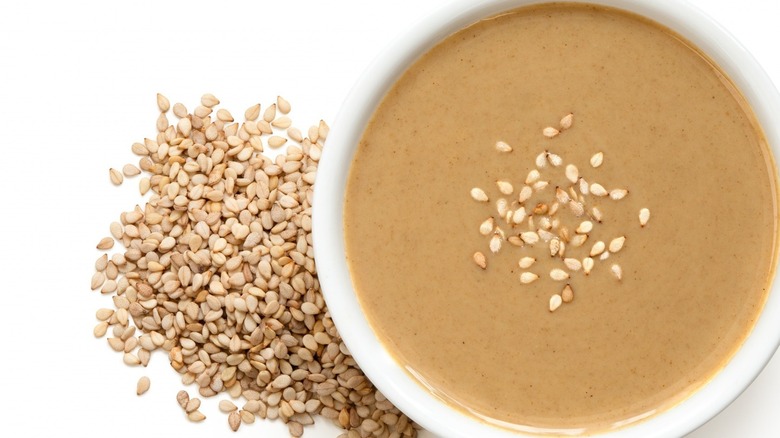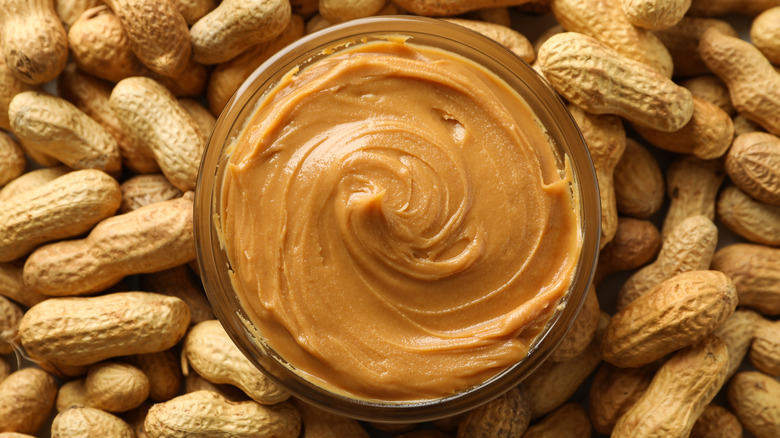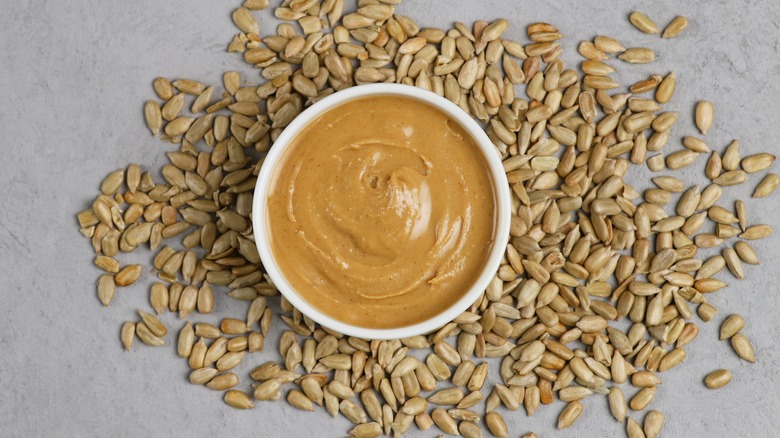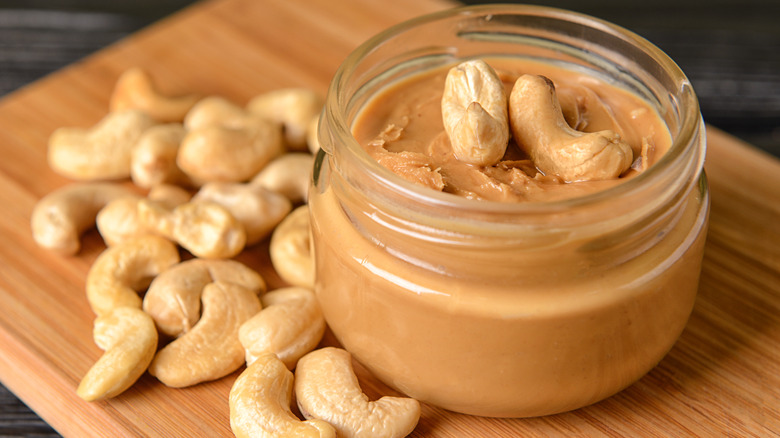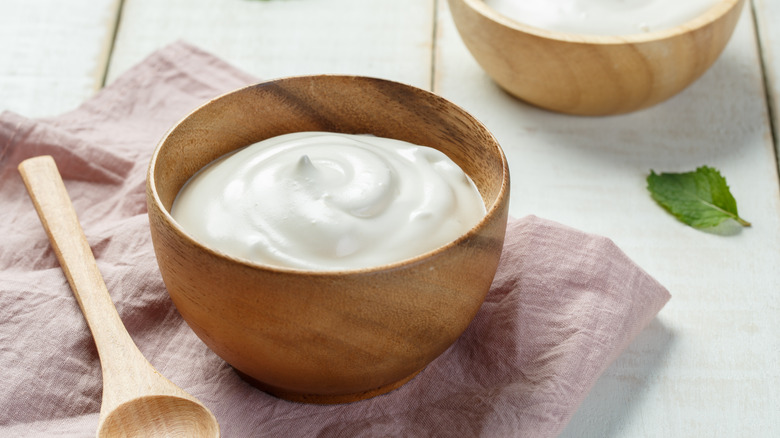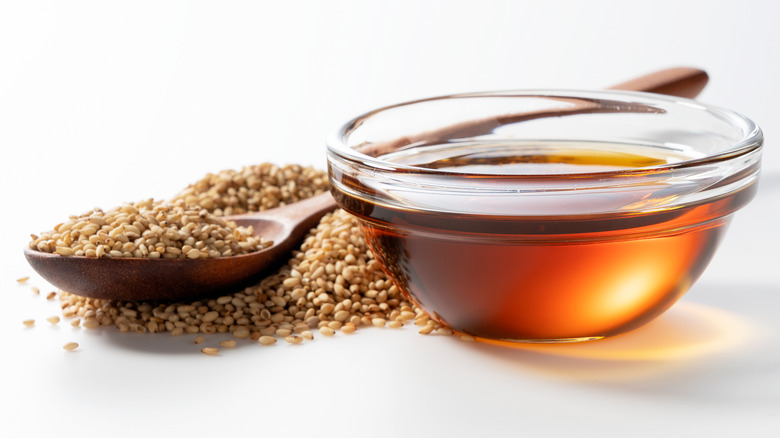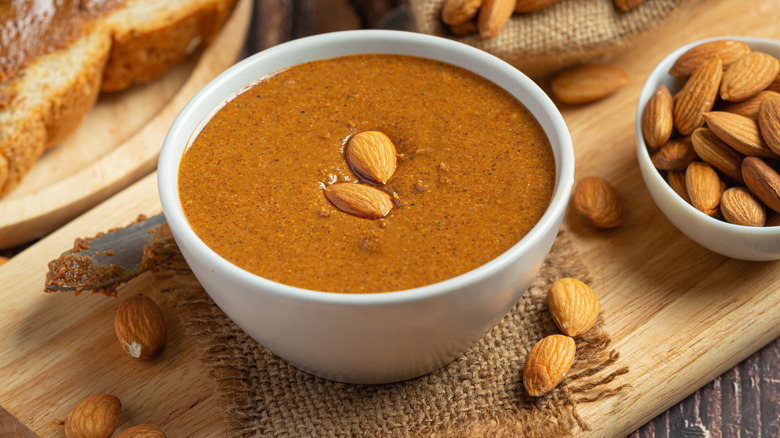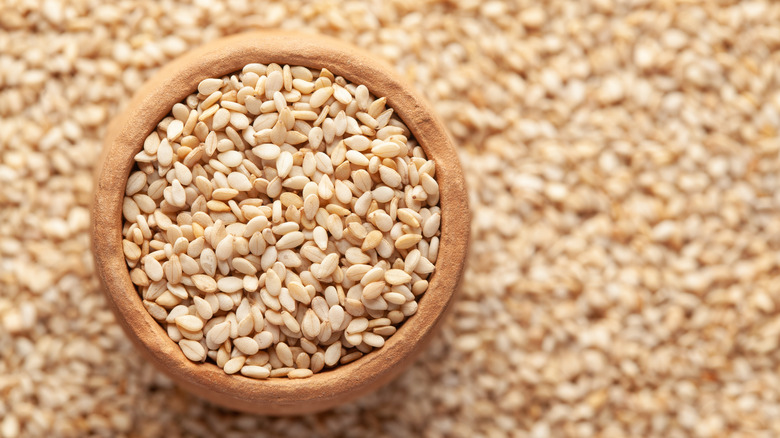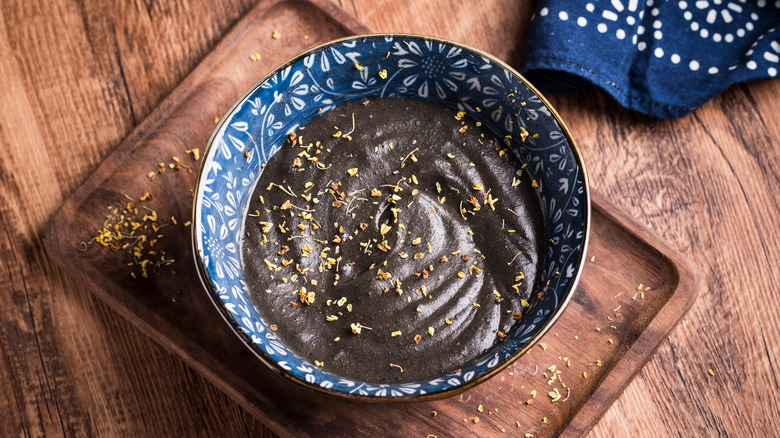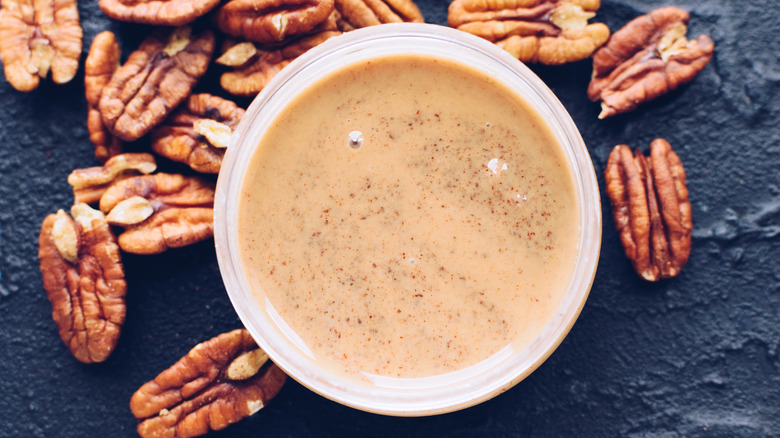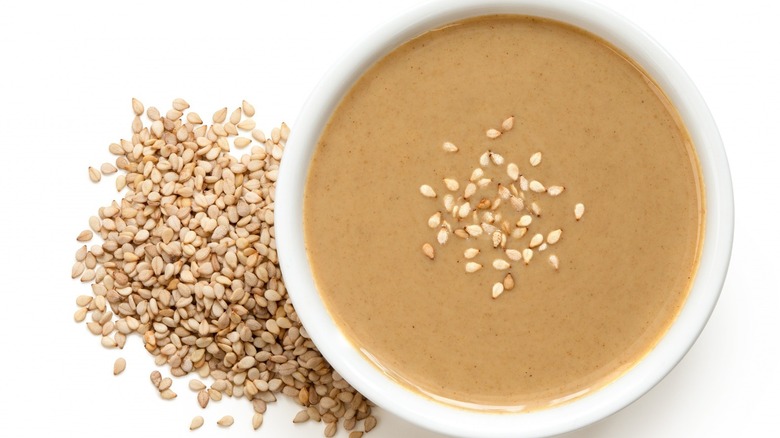10 Best Substitutes For Tahini
Noted for its thick and creamy texture, nutty taste, and hint of bitterness, tahini has been a requisite ingredient in larders across the Mediterranean and Middle East for years. Made from toasted sesame seeds grounded into a paste with oil, this condiment is greatly appreciated for its simplicity. While North Americans tend to think of it as a key component in a hummus or baba ganoush recipe, it is an integral part of many other delectable dishes. Whether you're whipping up a batch of tahini cookies, yogurt cake, or eggplant gazpacho, tahini's versatility and unique flavor will make it one of your go-to ingredients.
Furthermore, tahini is a healthy addition to any diet, boasting a lengthy list of potential benefits that includes cancer-fighting antioxidants, antibacterial properties, compounds that promote brain health and fight inflammation, and the ability to improve both liver and kidney function. Plus, it's vegan. If you're convinced about tahini and ready to get your own, know that the pantry ingredient needs to be stored in the fridge once opened to prevent the oils from going rancid (via Kitchn). Or, if you're armed with a food processor or strong blender, you can easily whip up some homemade tahini paste of your own.
But what happens when you find yourself in the midst of a tahini emergency — this is a real thing — and you don't have a jar in your pantry? Thankfully, you can take a deep breath, stop panicking, and reach for one of these 10 possible substitutes.
1. Peanut butter
Unless someone in your household is allergic to peanuts, the odds are you have a jar of peanut butter in your pantry right now. This popular condiment's ready availability is what makes it a great stand-in for tahini. In order for it to work, however, it must be smooth — not crunchy. Peanut butter possesses a similar creamy texture as tahini and is much more affordable than many other nut butters, but it does come with one caveat: It has a much stronger flavor than tahini. Yes, it's a yummy flavor, but it can overpower your dish if you use too much. To address this, it is recommended that you use peanut butter sparingly or make it taste more like tahini by stirring in some sesame oil, TofuBud suggests. PB is best used to substitute tahini in baked goods, like cookies and cakes, or when blended with sesame oil to make sauces.
Substitute half the amount of peanut butter (mixed with a bit of sesame oil, if possible) for the full amount of tahini in a recipe, per Kitchenous.com.
2. Sunflower seed butter
Sunflower seed butter or "sun butter" is made from sunflower seeds and makes a great replacement for tahini. Like tahini, it is made from seeds instead of nuts, but is less pourable in consistency. Similarly to the peanut butter trick, you can add a small amount of sesame oil to make it taste more like tahini and have a similar, thinner texture. If you're in a pinch, you can also use canola oil, but it won't deliver the same toastiness. An important thing to remember is that some sunflower seed butters contain added sugar, and this sweetness could distort the outcome of your dish. Stick with the unsweetened kind when creating savory dishes, Verywell Fit recommends. If you find yourself without store-bought sunflower seed butter, you can make your own — all you need is a stash of sunflower seeds.
Sunflower seed butter can be used on a 1:1 ratio when replacing tahini.
3. Cashew butter
Cashew butter costs more than a number of other possible substitutions for tahini, but it has some characteristics that make it a viable option. Made from ground cashews, it possesses a much milder flavor than its cousin, the peanut. In fact, as Bake It With Love notes, it may not be an exact flavor match with tahini, but it is the mildest-tasting nut butter. This neutral taste, along with its smooth texture, enables you to use it in a wide variety of both sweet and savory recipes without worry, from creamy sauces to hearty soups. Of course, as is the case with all nut butters, it is important to keep in mind that they pose a hazard to anyone with nut allergies who normally uses tahini for its nut-free quality.
You can substitute tahini with cashew butter on a 1:1 ratio, making dinnertime extra easy.
4. Greek yogurt
While Greek yogurt may seem like an unlikely substitute for tahini — it being a dairy product with a very distinctive taste and all — it is actually touted as a highly viable fill-in. As a bonus, it's a great alternative for those who suffer from seed allergies, while its high concentration of protein and low calorie count should appeal to those on certain diet plans.
Of course, unlike the nut and seed butters that feature on this list, Greek yogurt has a completely different flavor profile than tahini. While it doesn't have tahini's nutty, toasty taste, it does share its thick creaminess, making it a solid option for dips and sauces. Be sure to use extra care if cooking at high temperatures: As Kitchenous warns, if you are making a soup or sauce, stir it in at the end so the dairy doesn't curdle and split.
Greek yogurt can be employed in a 1:1 ratio in place of tahini.
5. Sesame oil
With both tahini and sesame seed oil originating from sesame seeds, they naturally share some common tasting notes. So, if it's the taste of sesame you're looking for, this substitute will give you a home run. If it's tahini's texture that you're after, however, this is not the right substitute for you, especially if you are trying to create a thicker sauce or dip like hummus. Sesame oil is much thinner than many of the other substitutions listed here, so you may be better off using a nut butter in these instances.
And if you're instead looking for a tahini substitute that's more keto-friendly, Verywell Fit reminds us that sesame oil is fattier and more caloric than tahini but has no sugar, sodium, or carbohydrates. While it's not as filling as tahini since it's low in protein and fiber, it may be a good option for cooks with particular diet goals.
Use half as much sesame seed oil as you would tahini in your recipes.
6. Almond butter
While almond butter often comes with a heftier price tag than tahini, it is a very good stand-in — unless you are preparing your dish for someone with nut allergies. Bake It With Love elaborates that almond butter does have a stronger nut flavor than tahini, so it won't be a perfect stand-in for every recipe. It will, however, work well in baked items, like cookies, or sauces in which a nutty taste is desirable. In terms of texture, the match is nearly perfect.
What's more, almond butter is a tahini substitute you can feel great about eating: It contains monounsaturated fats that can help promote healthy cholesterol levels in the body. It is also a good source of heart-benefitting omega-3 fatty acids and has significant amounts of vitamin E, calcium, potassium, and iron.
When replacing tahini with almond butter, use a 1:1 ratio and adjust to taste from there.
7. Sesame seeds
Since tahini is simply sesame seeds ground into a paste, it would make sense that sesame seeds, themselves, would make a great tahini substitute. In fact, if you are feeling adventurous, you could pull out the food processor and whip up a batch of homemade tahini using your stash of sesame seeds and your most neutral-tasting oil. But enough about all that work: You can instead use the simple sesame seed in its natural form as a substitute for tahini.
The first thing to remember, points out The Stone Soup, is that sesame seeds will give you the same nutty and slightly bitter flavor as tahini, but with a totally dissimilar texture. After all, they are not a paste; they are hard, crunchy seeds. This means they will work best when sprinkled into salads, desserts, and even marinades, rather than in smooth dishes. It's best to get your paws on toasted sesame seeds for this purpose, as they taste more like tahini, per Flavorful Home. You can, however, opt to toast the raw ones yourself.
Try 1 teaspoon of sesame seeds for every tablespoon of tahini in your recipe.
8. Black sesame paste
While tahini is a paste made from white sesame seeds, black sesame paste (or kuro neri goma, as it is known in Japanese) is made in a similar way with black sesame seeds. The flavors are quite close, with the black version having a somewhat nuttier taste. Moon and Spoon and Yum shares that you can find both sweetened and unsweetened versions and choose whichever is best for your recipe.
There are, however, a few problems with using black sesame paste as a substitution for tahini. First, it is difficult to find if you don't live near an Asian grocery store and is much pricier than tahini. The other important consideration is the color, as you probably don't want to dip your carrots into gray hummus (unless it's Halloween). Instead, the best recipes for using this replacement should be dark in color to begin with, like chocolaty cakes, cookies, or other desserts, per My Pure Plants.
Black sesame paste can replace tahini on a 1:1 ratio.
9. Pecan butter
Pecans have played the starring role in pecan pie for years, but it turns out that they make an excellent understudy for tahini, ready to step into its shoes on a moment's notice. With a nutty flavor and similarly viscous texture, pecan butter is a great tahini substitute — but, as Moon and Spoon and Yum offers, is pretty thick. You can adjust the consistency by stirring in a small amount of water.
Pecan butter offers some health benefits as well, including being high in iron, vitamin A, manganese, and zinc; providing a good dose of fiber; and offering antioxidants. While store-bought pecan butter is very expensive, you can easily whip up some of your own homemade pecan butter with just a food processor, a glass jar, and two cups of pecan halves.
Like most other nut butters, pecan butter can replace tahini at a 1:1 ratio.
10. Homemade tahini
Homemade tahini seems like it should be the most obvious replacement for its store-bought sibling, but there is a reason it isn't at the top of the list — namely because it is unlikely that you have a sizable enough helping of sesame seeds at your disposal. If you do, however, you are in luck. Making your own tahini is super easy. Mashed's homemade tahini recipe specifies that you simply need to toast your sesame seeds until they're golden, blend them with sesame seed oil (or a neutral tasting one like canola oil), ground it into a smooth paste in your food processor, and — voila — you've got DIY tahini. The taste of homemade tahini is a dead ringer for the mass-produced version, and perhaps even better. The only difference may be the consistency, depending on how much oil you use.
Use, you guessed it, a 1:1 ratio for your substitution.
